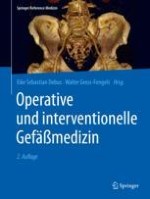2020 | OriginalPaper | Buchkapitel
62. Aneurysmen der Aorta descendens und der thorakoabdominellen Aorta: Endovaskuläre Therapie und Hybridverfahren
verfasst von : Franziska Heidemann, Eike Sebastian Debus, Tilo Kölbel
Erschienen in: Operative und interventionelle Gefäßmedizin
Verlag: Springer Berlin Heidelberg











